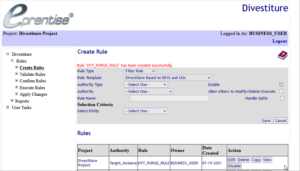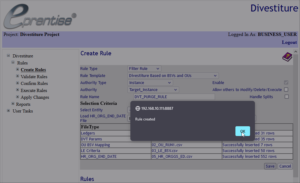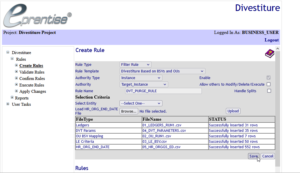Divestiture
There are several considerations when you decide to carve out or sell part of your business. First and foremost is what are you going to separate? Sometimes that is not an easy decision. For example, you might decide that you want to sell off your Chinese entities, but all the data is embedded in your Asia-Pacific operations including the fact that the China entity is the major supplier for other parts of the company. Once you have decided what to separate, you need to decide how to separate data, people, and products into two or more separate companies. The selling company is called the parent, and the entity being carved-out is called the child company.
eprentise provides a full divestiture solution, whether it is creating a stand-alone company for the divested entity, cleaning the confidential data out of the parent instance, moving the data to a separate ledger and operating unit, or changing the calendar and revaluing the assets as of the date of the acquisition. Using eprentise Divestiture software, you can create separate Oracle® E-Business Suite (EBS) databases for both the parent and child companies.


How It Works

Features and Benefits

Example Scenarios

Highlighted Resources
Using sophisticated filtering criteria, the software can separate data at any level resulting in complete, consistent, and correct information so that both the parent and child can operate completely independently. The child instance only contains data relative to the child company, and the parent instance removes the child’s data from the remaining instance. (A backup copy with the full data set may be created as a reference and stored in a remote location if necessary).
eprentise Software starts with a clone of the parent instance and purges data that is not related to the child instance as identified by filter criteria identified by the client.
You can easily separate and purge data based on any type of criteria either from the top-down (i.e. Legal Entities, Ledgers, Operating Unit, or Balancing Segment Value, etc.) or bottom up (i.e. Inventory Orgs, or even an Item SKU). eprentise Software finds all data related to one or more criteria and does a complete purge of unrelated data.
Problem:
A large entertainment company sold their mobile media division to a competitor company. They don’t want the new buyer to be able to see their confidential data such as contracts, discounts, cost of goods sold, and suppliers from the other segments of the business that weren’t being sold.
Solution:
Using eprentise Divestiture software, the company created filter criteria to separate and purge data based on their product category flexfield in the Oracle® E-Business Suite. Once the rules were created, eprentise Software purged all master data and transactions not related to the mobile media division.
Problem:
A government contractor was sold to a foreign entity. The part of the organization that did business with the US government needed to remain in a US data center, and was not able to be operated by the foreign entity.
Solution:
eprentise Reorganization Software was used to separate the data after the acquisition by the foreign entity, and later moved to a separate data center and sold to another US-based buyer.
- Since the software starts with a clone, all data including history remains in the instance, and there is very little modification, even for Customizations, Enhancements, Modifications, Localizations, or Interfaces (CEMLIs). Everything that worked in the original instance will work in the separated instance.
- You can filter by one criteria, or multiple criteria. The criteria are turned into rules in eprentise’s Metadata Analysis Rules Repository and eprentise Divestiture Software purges all related data in the correct order to maintain the relational and data integrity in a stand-alone instance that fully meets the separation criteria and gets the results that you want..
- A scope and configuration phase of the project defines the criteria and scope of the project for each type of data. That criteria is translated into rules in the eprentise Rules Repository
- eprentise Software applies the criteria to configuration data, master data, and all transactions.
- Co-mingled data is separated so that the resulting accounting accurately reflects the portion of the transaction only related to the child entity, and recalculates all balances so that there is a complete accounting record for auditors and for taxes.
- Standard Oracle reports run as a baseline before the separation and again after the separation provide a full audit trail of what was purged.
- No training or implementation required because both instances are fully configured and ready for operations in a short time frame
- Retains all of the historical information pertinent to each operation
- No programming required. This is commercial software that has been used in many clients’ environments. The process is repeatable, and gets consistent results while minimizing the risks.
- Results in complete, consistent, and correct data
- eprentise Reorganization Software may also be used to separate data but leave it in the same instance instead of purging the data to create a stand-alone instance for the child company.
- eprentise Calendar Change Software may also be used to close the year’s accounting on the date of the acquisition and adjust the retained earning.
- Review a product overview presentation
- Read our Divestiture Datasheet
- Watch this webinar: Who Does What, When, and How for a Divestiture?
- Check out these whitepapers:
- Learn from Teri Williamson about Merging Data: A Methodology
Product Screens




